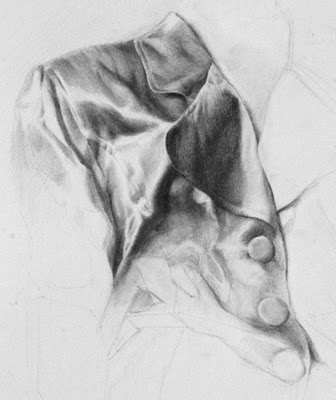Ted Seth Jacobs - Drapery Study
 Sunday, February 24, 2008 at 8:00PM
Sunday, February 24, 2008 at 8:00PM 18 x 24 inches (detail)
I've just finished 12 weeks studying drawing with Ted Seth Jacobs at BACAA. We spent the final week modeling a satin jacket which was put on a mannequin. It was an amazingly difficult final project, it really felt like a test of everything Ted has been teaching us about how to analyze three dimensional form.
These are the 4 main principles Ted taught us to apply when analyzing form:
Convex Form
Everything in nature is curved, nothing is flat. All of these curves are convex, there are no concavities. If you look closely at a seemingly-concave drape or indentation, you can always see small convexities along it. This is evidence of the underlying structure. (It sounds implausible, everyone doubts it when they first hear it, but try seeing it, it's there).
Wide to Narrow
Nothing in nature is parallel, every shape starts wide on one end and gets narrow on the other. A shadow shape will always be a fan, not a square or rectangle. Use this concept to "shape the light".
Rounding and Ending
Every shadow rounds over a curved surface and ends before the next form begins. This means every form shadow has a soft edge and a hard edge. Think about the direction of the light - generally the edge of a shadow closer to the light source will be soft, and the edge away from the light will be hard.
What's in Front
The only point on an object not foreshortened is the point directly in front of your eye, everything else is foreshortened. That means every form is in front of or behind another. There are thousands of tiny "horizons", the edge of a shape we look across to see the next shape.
The hardest part is that all of these principles apply to every form. A rounding-and-ending shadow has a wide-to-narrow shape and it always describes a convex form which is in front or behind something else.


Reader Comments (1)
I welcome your comments and learn so much from what you say. I am a self taught artist and only wish that I had had the opportunity to go to an art school. I am grateful to you for all your efforts to keep your readers informed. Perhaps I will be one of the lucky ones who succeed without having gone to an art school.